|
 |
|
THE APOSTLES & EARLY CHURCH FATHERS |
| 1. Simon Peter | 2. Andrew | 3. James (son of Zebedee) | 4. John |
| 5. Philip | 6. Bartholomew | 7. Mathew | 8. Thomas |
| 9. James (Jacob the Less) | 10. Jude Thaddaeus | 11. Simon the Zealot | 12. Mathias |
| 13. Paul | 14. Mark | 15. Luke | 16. Barnabas |
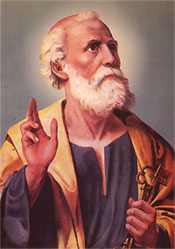 |
Feast: June 29.
St. Peter was a fisherman of Galilee, named Simon, and the son of John. His brother Andrew introduced him to Christ about whom they had probably heard from John the Baptizer, and he became His disciple, ultimately giving up his family and possessions to follow Him. Christ changed his name to Peter (Rock) and made him the Rock on which His Church was to be built. After His Resurrection, Jesus conferred the primacy on Peter and he became the Vicar of the Christ and the head of the Apostles, the first Patriarch.
The Gospels speak about Peter more than any other Apostle. He was honoured on many occasions; several miracles were performed for his benefit; Christ stayed at his home, preached from his boat, sent him the first message of the Resurrection, and appeared to him personally. Often Peter acted as a spokesman for the other Apostles. Finally, mention is made of his defects: his anger, imperfect faith, impetuosity, and his triple denial of Christ.
After the Ascension Peter began his work as head of the Church. He directed the election of Matthias, delivered the first public Apostolic sermon, cured a man lame from birth, and received a Divine commission to receive Gentiles into the Church. After the execution of James, the brother of John, by Herod Agrippa, Peter was miraculously rescued from prison. He presided at the Apostolic Council of Jerusalem in the year 50, when it was officially declared hat the Gentile converts to the Faith were not subject to the Jewish law of circumcision. Later it was decided that not even the Jews were bound to observe the Mosaic Law.
On 22nd Feb AD 37, Saint Peter founded the see of Antioch which is attested by many Saints of the earliest times, including Saint Ignatius of Antioch and Pope Saint Clement. This Apostolic Throne at Antioch is acknowledged as the first See of Peter. It was just that the Prince of the Apostles should take under his particular care and surveillance this city, which was then the capital of the East, and where the faith so early took such deep roots as to give birth there to the name of CHRISTIANS. There his voice could be heard by representatives of the three largest nations of antiquity — the Hebrews, the Greeks and the Latins. Saint Chrysostom says that Saint Peter was there for a long period; Saint Gregory the Great, that he was seven years Bishop of Antioch. He did not reside there at all times, but governed its apostolic activity with the wisdom his mandate assured. All the historical evidences points to the fact that the date of establishment of the Apostolic Throne at Antioch is within few years after Our Saviour’s Ascension. The Apostle no doubt left Jerusalem when the persecution which followed Saint Stephen's martyrdom (AD.35) broke out (Acts 8:1), and remained in Antioch until he escaped miraculously from prison and from the hands of Herod Agrippa, while in Jerusalem in 43 at the time of the Passover. (Acts 12) Knowing he would be pursued to Antioch, his well-known center of activity, he went to Rome.
St. Peter's Cave Church (Grotto) at Antioch (Antakya, now in Turkey),
established by the Apostle
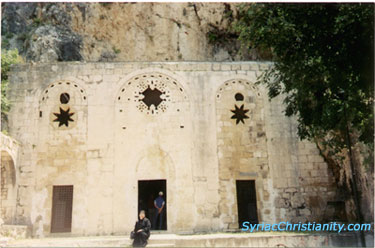 |
In the first ages it was customary, especially in the East, for every Christian to observe the anniversary of his Baptism. On that day each one renewed his baptismal vows and gave thanks to God for his heavenly adoption. That memorable day they regarded as their spiritual birthday. The bishops similarly kept the anniversary of their consecration, as appears from four sermons of Saint Leo the Great on the anniversary of his accession to the pontifical dignity. These commemorations were frequently continued by the people after their bishops’ decease, out of respect for their memory. The feast of the Chair of Saint Peter was instituted from very early times. Saint Leo says we should celebrate the Chair of Saint Peter with no less joy than the day of his martyrdom, for as in the latter he was exalted to a throne of glory in heaven, by the former he was installed Head of the Church on earth.
From Antioch, St. Peter went to Rome where he stayed there intermittently for about 25 years, as founder and first bishop of the Church there. Finally, in the last year of Nero’s reign, 67, he was crucified with his head downward, at his own request, not deeming himself worthy to die as did his Divine Master. Two Epistles of the New Testament are attributed to him and the Gospel of St. Mark, who was his disciple, has been called “the Gospel of Peter.”
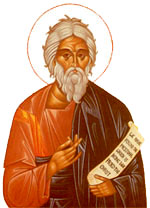
Feast: November 30.
St. Andrew, the brother of St. Peter, was a native of the town of Bethsaida in Galilee, and a fisherman by profession. Being first a disciple of St. John the Baptist, he later joined Jesus, also brought to Him his brother Simon, with whom he became a member of the Apostolic College. After the dispersion of the Apostles, St. Andrew preached the Gospel in Scythia, as we learn from Origen; and, as Sophronius says, also in Sogdiana and Colchis.
According to Theodoret, St. Gregorius Nazianzen, and St. Jerome, he also laboured in Greece. It is even believed that he carried the Gospel as far as Russia and Poland, and that he preached at Byzantium. He suffered martyrdom at Patras in Achaia (AD 60), and, according to ancient authorities, by crucifixion on a cross in the form of an X.
The body of the saint was taken to Constantinople in 357, and deposited in the church of the Apostles, built by Constantine the Great. In 1270, when the city fell into the hands of the Latins, the relics were transported to Italy and deposited in the Cathedral of Amalfi.
ST. JAMES, the son of Zebedee
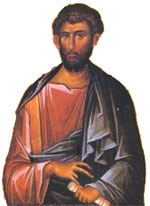
Feast: May 1.
St. James (Jacob) is usually called “the Greater” in order to distinguish him from the other Apostle James, the “brother: of the Lord, who is called “the Less”. He was the brother of St. John the Evangelist (sons of Zebedee and Salome) and came from Bethsaida in Galilee, where his father owned a fishing boat.
The two youths were fishing with their father when Jesus came by and invited them to follow him. They became such dedicated and zealous followers that our Lord styled them Boanerges, or sons of thunder. They were present at the cure of St. Peter’s mother-in-law, the raising of Jairus’ daughter, and the Transfiguration, and were near Christ in His Agony in the garden.
One day their mother asked Jesus to assure a place of honour for her sons in His future Kingdom. When He asked if they were able to bear the cup of His sufferings, their answer was typical of them: indeed they could! And indeed they did!
After the dispersion of the Apostles, St. James preached the Gospel in Spain and then returned to Jerusalem, where he was the first of the Apostles to drink the cup of Christ’s sufferings. By order of Herod Agrippa he was beheaded at Jerusalem around the feast of Easter, in the year 44.
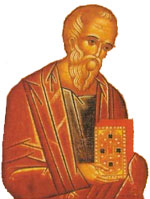
Feast: May 8.
St. John, the son of Zebedee, and the brother of St. James the Great, was called to be an Apostle by our Lord in the first year of His public ministry. He became the “beloved disciple” and the only one of the twelve who did not forsake the Saviour in the hour of His Passion. He stood faithfully at the Cross, whence the Saviour made him the guardian of His Mother.
His later life was passed chiefly in Jerusalem and Ephesus. He founded many churches in Asia Minor. He wrote the fourth Gospel, and three Epistles, and the Book of Revelation is also attributed to him. Brought to Rome, tradition relates that he was by order of Emperor Domitian cast into a caldron of boiling oil but came forth unhurt and was banished to the island of Patmos for a year. He lived to an extreme old age, surviving all his fellow Apostles, and died at Ephesus about the year 100.
St. John was said to be so generous in charity; a virtue he had learned from his Divine Master, and which he constantly inculcated by word and example. The “beloved disciple” died at Ephesus, where a stately church was erected over his tomb. It was afterwards converted into a Mohammedan mosque.
St. John is one of the very famous Apostles. The apostle died at Ephesus, where a stately church was eructed over his tomb. It was afterwards converted into a Mohammedan mosque.
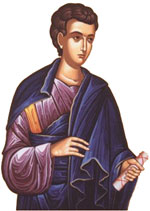
Feast: November 14.
St. Philip, a native of Bethsaida in Galilee, was called by our Lord the day after St. Peter and St. Andrew. We learn from tradition that he was then a married man, and that he had several daughters, three of whom reached eminent sanctity. Like the other Apostles, St. Philip left all things to follow Christ. His name is frequently mentioned in the Holy Gospels.
After the Ascension of his Divine Master, St. Philip preached the Gospel in that part of Asia Minor called Phrygia, which was then a province of the Roman Empire. It is supposed that he was buried at Hierapolis in Phrygia (AD 80).
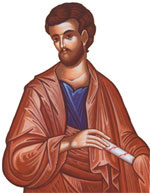
Feast: June 11.
Many scripture scholars identify (reasonably but not conclusively) St. Bartholomew with Nathaniel who was conducted to Christ by St. Philip. The name of Bartholomew signifies son of Tolmai, and it was given to the saint in the same sense that “Bar Jonah” was attached to St. Peter. He was chosen by our Lord Himself to be one of the Twelve Apostles.
According to Eusebius and other ancient writers, he preached the Gospel in the most barbarous countries of the East, penetrating as far as India. Eusebius relates that when St. Pantaenus, in the 3rd century, went to India, he still found the knowledge of Christ in that country, and a copy of the Gospel of St. Matthew in Hebrew was shown to him, which he was told had been brought there by St. Bartholomew.
St. John Chrysostom says that St. Bartholomew brought the Faith to the people of Lycaonia. According to St. Gregory of Tours, the last field of his labours was Great Armenia, where, preaching in a place obstinately addicted to the worship of idols, he suffered martyrdom. By some it is said that he was flayed alive; by others, that he suffered crucifixion-both these opinions being reconcilable. The relics of the saint are preserved in the church of St. Bartholomew on the island in the Tiber River near Rome.
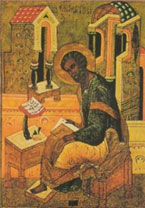
Feast: February 24.
St. Matthew, one of the twelve Apostles, is the author of the first Gospel. This has been the constant tradition of the Church and is confirmed by the Gospel itself. He was the son of Alpheus and was called to be an Apostle while sitting in the tax collector’s place at Capernaum. Before his conversation he was a publican, ie., a tax collector by profession. He is to be identified with the “Levi” of Mark and Luke.
His apostolic activity was at first restricted to the communities of Palestine. Nothing definite is known about his later life. There is a tradition that points to Ethiopia as his field of labour; other traditions make mention of Parthia and Persia. It is uncertain whether he died a natural death or received the crown of martyrs.
St. Matthew’s Gospel was written to fill a sorely-felt want for his fellow countrymen, both believers and unbelievers. For the former, it served as a token of his regard and as an encouragement in the trial to come, especially the danger of falling back to Judaism; for the latter, it was designed to convince them that Messiah had come in the Person of Jesus, our Lord, in whom all the promises of the Messianic Kingdom embracing all people had been fulfilled in a spiritual rather than in a carnal way: “My Kingdom is not of his world.” His Gospel, then, answered the question put by the disciples of St. John the Baptist, “Are You He Who is to come, or shall we look for another?”
Writing for his countryman of Palestine, St. Matthew composed his Gospel in his native Aramaic, the “Hebrew tongue” mentioned in the Gospel and the Acts of the Apostles. Soon afterward, about the time of the persecution of Herod Agrippa I in 42 A.D., he took his departure for other lands. Another tradition places the composition of his Gospel either between the time of this departure and the Council of Jerusalem, ie., between 42 A.D. and 50 A.D., or even later. Definitely, however, the Gospel itself, depicting the Holy City with its altar and temple as still existing, and without any reference to the fulfillment of our Lord’s prophecy, shows that it was written before the destruction of the city by the Romans (70 A.D.), and this internal evidence confirms the early traditions.
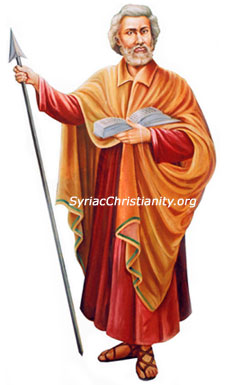
Feast: July 3 & December 21.
St. Thomas (Mor Toma in Syriac) was a Jew, called to be one of the twelve Apostles. He was a dedicated but impetuous follower of Christ. When Jesus said that He was returning to Judea to visit His sick friend Lazarus, Thomas immediately exhorted the other Apostles to accompany Him on the trip which involved certain danger and possible death because of the mounting hostility of the authorities. At the Last Supper, when Christ told His Apostles that He was going to prepare a place for them to which they also might come because they knew both the place and the way, Thomas pleaded that they did not understand and received the beautiful assurance that Christ is the Way, the Truth, and the Life.
But St. Thomas is best known for his role in verifying the Resurrection of His Master. Thomas’ unwillingness to believe that the other Apostles had seen their Risen Lord on the first Easter Sunday merited for him the title of “doubting Thomas.” Eight days later, on Christ’s second apparition, Thomas was gently rebuked for his skepticism and furnished with the evidence he had demanded-seeing in Christ’s hands the point of the nails and putting his fingers in the place of the nails and his hand into His side. At this, St. Thomas became convinced of the truth of the Resurrection and exclaimed: “My Lord and my God,” thus making a public Profession of Faith in the Divinity of Jesus.
St. Thomas is also mentioned as being present at another Resurrection appearance of Jesus-at Lake Tiberias when a miraculous catch of fish occurred. This is all that we know about St. Thomas from the New Testament.
Tradition says that at the dispersal of the
Apostles after Pentecost this saint was sent to evangelize the Parthians, Medes
and Persians; he ultimately reached India, carrying the Faith to the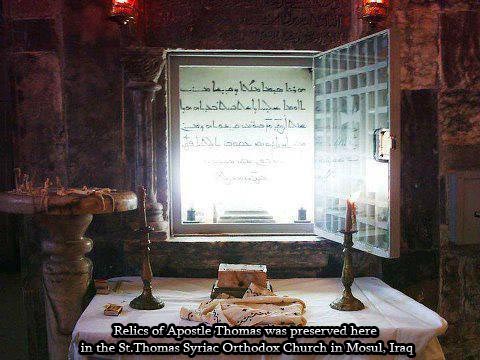 Malabar
Coast, which still boasts a large native population calling themselves
“Christians of St. Thomas.” He capped his life by shedding his blood for His
Master, speared to death at a place called Calamine and buried at Mylapore, near
Chennai (Madras). This is mentioned in the Gnostic Acts of Thomas in
Syriac, where he is called Judas Thomas. It is believed that the Apostle arrived
in India in AD 52 and was martyred in AD 72. The Syriac Christians of Malabar,
the Southwest coast of India, call themselves 'St. Thomas Christians'. It is
believed that his body was transferred to Edessa in the 4th century; St.
Ephrem's works note that the bones of St. Thomas were venerated there in his
time. The great hymnodist alludes to the transferral of the bones in his
Carmina Nisibena (42:1.1-2.2, Kathleen McVey, Ephrem the Syrian,
Paulist Press, 1989, p. 25).
Malabar
Coast, which still boasts a large native population calling themselves
“Christians of St. Thomas.” He capped his life by shedding his blood for His
Master, speared to death at a place called Calamine and buried at Mylapore, near
Chennai (Madras). This is mentioned in the Gnostic Acts of Thomas in
Syriac, where he is called Judas Thomas. It is believed that the Apostle arrived
in India in AD 52 and was martyred in AD 72. The Syriac Christians of Malabar,
the Southwest coast of India, call themselves 'St. Thomas Christians'. It is
believed that his body was transferred to Edessa in the 4th century; St.
Ephrem's works note that the bones of St. Thomas were venerated there in his
time. The great hymnodist alludes to the transferral of the bones in his
Carmina Nisibena (42:1.1-2.2, Kathleen McVey, Ephrem the Syrian,
Paulist Press, 1989, p. 25).
His relics were moved from Edessa later and rediscovered in 1964 at the Syriac Orthodox Church of Mosul by His Holiness Mor Ignatius Zakka I, the Patriarch of Antioch while he was the Archbishop of Mosul. Following the warlike situation in some parts of Iraq, the Holy Relics of Saint Thomas has been transferred from the St Thomas Church, Mosul to the Syriac Orthodox Monastery of St Matthew, Nineveh, Iraq on June 17, 2014 and kept in the Beth Khadeesha of Monastery.
There are a number of apocryphal writings under his name, most notably the Acts of St. Thomas which is of Syriac origin. This work dates back to the middle of the 3rd century. Translations in Greek, and portions in Latin, Ethiopic and Armenian exist.
The Church commemorates the memory of St. Thomas on July 3rd. The date marks the transfer of the remains of the Apostle to Edessa. The Church in India also commemorates the Apostle on the New Sunday after Easter, on December 18th when the Apostle is believed to have been speared, and on December 21st when he attained martyrdom.
Patriarch H.H. Ignatius Zakka I in an encyclical
dated October 20, 1987, added the name of "Apostle Thomas, the preacher of the
Holy Gospel of our Lord Jesus Christ in India" to the the fourth diptych (Syr.
Tubden) in the Malankara Church.
ST. JAMES the Less, the brother of the Lord
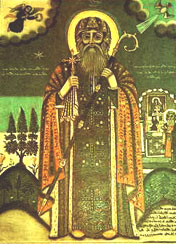 |
Feast: June 19 (October 23 ?).
St. James (Jacob) the Less, the author of the first Epistle, was the son of Alphaeus of Cleophas. His mother Mary was either a sister or a close relative of the Blessed Virgin, and for that reason, according to Jewish custom, he was sometimes called the brother of the Lord. The apostle held a distinguished position in the early Christian community of Jerusalem. St. Paul tells us he was witness of the Resurrection of Christ; he is also called a “pillar” of the Church, whom St. Paul consulted about the Gospel.
According to tradition, he was the first Bishop of Jerusalem, and was at the Council of Jerusalem about the year 50. He was the one who celebrated the Holy Mass for the first time. Saint James was regarded as head of the early Church in Jerusalem. The historians Eusebius and Hegesippus narrate that the Jews martyred St. James for the Faith by being thrown from the pinnacle of the temple in Jerusalem by the Pharisees and then stoned to death in the year 62, although they greatly esteemed his person and had given him the surname of “James the Just.”
Tradition has always recognized him as the author of the Epistle that bears his name. Internal evidence based on the language, style, and teaching of the Epistle reveals its author as a Jew familiar with the Old Testament, and a Christian thoroughly grounded in the teachings of the Gospel. External evidence from the early Fathers and Councils of the Church confirms its authenticity and canonicity.
The date of its writing cannot be determined exactly. According to some scholars it was written about the year 49 A.D. Others, however, claim it was written after St. Paul’s Epistle to the Romans (composed during the winter of 57-58 A.D.). It was probably written between the years 60 and 62 A.D.
St. James addresses himself to the “twelve tribes that are in the Dispersion,” that is, to Christians outside Palestine; but nothing in the Epistle indicates that he is thinking only of Jewish Christians. St. James realizes full well the temptations and difficulties they encounter in the midst of paganism and as a spiritual father, he endeavors to guide and direct them in the faith. Therefore the burden of his discourse is an exhortation to practical Christian living.
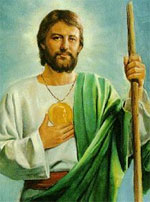
Feast: May 10.
St Jude Thaddeus (Thaddeus being his surname) is believed to be the brother of St. James the Lesser, and a relative of Jesus. St. Simon and he are known as the "humble Apostles", because in the Litany of the Saints they are tenth and eleventh in listing respectively; they are directly above Judas Iscariot. He is a relatively minor figure in the Gospels. The one major story (not included in the Gospels) that he is a major player in is the legend of the Mandylion (the medal with the image of Christ he is holding). According to Tradition, the King of Edessa was stricken with a deadly disease. He wrote to Jesus, asking for help. Jesus, not being able to go, pressed a cloth against His face, and sent it to the king in the care of St. Jude. The king was healed, and became a Christian. Tradition says that after Pentecost he traveled throughout Mesopotamia for a period of ten years, preaching and converting many to Christianity. He probably returned to Jerusalem for the Council of Apostles, and then he and St. Simon visited Libya and Persia where many more converts were made and eventually ended up in Armenia. The nobles there did not like his influence with the king (who he had healed), and killed him by knocking him out with a club, and then beheading him. His relics are under the Basilica of St. Peter in Rome. He is credited with writing the Epistle of Jude. His feast day is celebrated jointly with St. Simon on 10th May, while October 28th is the feast day celebrated by the Western Church.

Feast: May 10.
St. Simon is surnamed the Canaanean or Canaanite, and the Zealot, to distinguish him from St. Peter, and from St. Simeon, the brother of St. James the Less, and his successor in the see of Jerusalem. From the first of these surnames some have thought that St. Simon was born at Cana, in Galilee: certain modern Greeks pretend that it was at his marriage that our Lord turned the water into wine. It is not to be doubted but he was a Galilean. Theodoret says, of the tribe either of Zabulon or Nepthali. Hammond and Grotius think that St. Simon was called the Zealot, before his coming to Christ, because he was one of that particular sect or party among the Jews called Zealots, from a singular zeal they possessed for the honour of God and the purity of religion. Some modern writers have used his surname as the basis for conjectures associating him, and through him Jesus and all His original followers, with the Zealot movement described by Josephus, a Jewish independence movement devoted to assassination and violent insurrection. However, there were many movements that were called Zealot, not all alike, and Josephus tells us (Jewish War 4,3,9) that the movement he is describing did not arise until shortly before the destruction of the Temple in 70 AD.
Some ancient Christian writers say that Simon and Jude went together as missionaries to Persia, and were martyred there. If this is true, it explains, to some extent, our lack of historical information on them and also why they are usually put together. Simon is not mentioned by name in the New Testament except on these lists.
St. Simon, after his conversion, was zealous for the honour of his Master, and exact in all the duties of the Christian religion; and showed a pious indignation toward those who professed this holy faith with their mouths, but dishonoured it by the irregularity of their lives. No further mention appears of him in the gospels than that he was adopted by Christ into the college of the apostles. With the rest he received the miraculous gifts of the Holy Ghost, which he afterwards exercised with great zeal and fidelity. If this apostle preached in Egypt, Cyrene, and Mauritania, he returned into the East; for the Martyrologies of St. Jerome, Bede, Ado, and Usuard place his martyrdom in Persia, at a city called Suanir, possibly in the country of the Suani, a people in Colchis, or a little higher in Sarmatia, then allied with the Parthians in Persia; which may agree with a passage in the Acts of St. Andrew, that in the Cimmerian Bosphorus there was a tomb in a "rot, with an inscription importing that Simon the Zealot was interred there. His death is said in these Martyrologies to have been procured by the idolatrous priests. Neither his place of burial nor about any information of his relics is known. Several places claim to have been the site of his martyrdom. Those who mention the manner of his death say he was crucified.
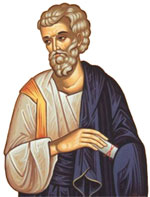
Feast: August 24.
From the Acts of the Apostles we learn that St. Matthias had been one of the companions of our Savior from the day of His baptism by St. John; for when there was question of electing an Apostle to take the place of the apostate Judas, St. Peter spoke: “Of these men who have been in our company all the time that the Lord Jesus moved among us, from John’s baptism until the day that He was taken up from us, of these one must become a witness with us of His Resurrection” (Acts 1, 21).
Two men were proposed: Barnabbas and Mathias, and the latter was chosen by lot. About one hundred and twenty persons were present at this election presided by St. Peter, the chief among the Apostles. According to an ancient tradition handed down by St. Clement of Alexandria and confirmed by Eusebius and St. Jerome, St. Matthias was one of the seventy-two disciples of our Lord. It was after this concurrence that the Holy Spirit descended upon the Apostles, among whom St. Matthias was then numbered.
St. Clement of Alexandria writes that St. Matthias was remarkable for inculcating the necessity of mortifying the flesh with its irregular passions and desires. According to the Greeks, St. Matthias suffered martyrdom in Colchis, which is called Ethiopia. Colchis was a district of Asia Minor, situated on the shores of the black Sea, south of the Caucasus Mountains.
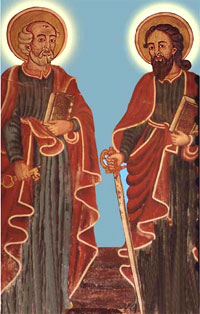 |
| St.Peter & St.Paul |
Feast: June 29.
Though not one of the Twelve, St. Paul is considered an Apostle by the Church. He was born at Tarsus, Cilicia, of Jewish parents who were descended from the tribe of Benjamin and was a Roman citizen by birth. As he was “a young man” at the stoning of St. Stephen and “an old man” when writing to Philemon, about the year 63, he was probably born around the beginning of the Christian era.
To complete his schooling, St. Paul was sent to Jerusalem, where he sat at the feet of the learned Gamaliel and was educated in the strict observance of the ancestral Law. Here he also acquired a good knowledge of exegesis and was trained in the practice of disputation. As a convinced and zealous Pharisee, he returned to Tarsus before the public life of Christ opened in Palestine.
Some time after the death of Our Lord, St. Paul returned to Palestine. His profound conviction and emotional character made his zeal develop into a religious fanaticism against the infant Church. He took part in the stoning of the first martyr, St. Stephen, and in the fierce persecution of the Christians that followed.
Entrusted with a formal mission from the high priest, he departed for Damascus to arrest the Christians there and bring them bound to Jerusalem. As he was nearing Damascus, about noon, a light from heaven suddenly blazed round him. Jesus with His glorified body appeared to him and addressed him, turning him away from his apparently successful career. An immediate transformation was wrought in the soul of St. Paul. He was suddenly converted to the Christian Faith and became an Apostle.
He remained some days in Damascus after his Baptism, and then went to Arabia, possibly for a year or two, to prepare himself for his future missionary activity. Having returned to Damascus, he stayed there for a time, preaching in the synagogues that Jesus is the Christ, the Son of God. For this he incurred the hatred of the Jews and had to flee from the city. He then went to Jerusalem to see St. Peter and pay his homage to the head of the Church.
Later he went back to his native Tarsus (acts 9, 30) and began to evangelize his own province until called by Barnabas to Antioch. After one year, on the occasion of a famine, both Barnabas and Paul were sent with alms to the poor Christian community at Jerusalem. Having fulfilled their mission, they returned to Antioch.
Soon after this Paul and Barnabas made the first missionary journey (44/45-49/50), visiting the island of Cyprus, then Pamphylia, Psidia, and Lycania, all in the Asia Minor, and establishing churches at Pisidian Antioch, Iconium, Lystra, and Derbe.
After the Apostolic Council of Jerusalem, Paul, accompanied by Silas and later also by Timothy and Luke, made his second missionary journey (50-52/53), first revisiting the churches previously established by him in Asia Minor and then passing through Galatia. At Troas a vision of a Macedonian was had by Paul, which impressed him as a call from God to evangelize Macedonia. He accordingly sailed for Europe, and preached the Gospel in Philippi, Thessalonica, Beroea, Athens, and Corinth. Then he returned to Antioch by way of Ephesus and Jerusalem.
On his third missionary journey (53/54-58) Paul visited nearly the same regions as on the second, but made Ephesus, where he remained nearly three years, the center of his missionary activity. He laid plans also for another missionary journey, intending to leave Jerusalem for Rome and Spain. Bur persecutions by the Jews hindered him from accomplishing his purpose. After two years of imprisonment at Caesarea he finally reached Rome, where he was kept another two years in chains.
The Acts of the Apostles gives us no further information on the life of the Apostle. We gather, however, from the Pastoral Epistles and from tradition that at the end of the two years St. Paul was released from his Roman imprisonment, and then traveled to Spain, later to the East again, and then back to Rome, where he was imprisoned a second time, and in the year 67 was beheaded.
St. Paul’s untiring interest in and paternal affection for the churches established by him have given us fourteen canonical Epistles. It is, however, quite certain that he wrote other letters which are no longer extant. In his Epistles, St. Paul shows himself to be a profound religious thinker, and he has had an enduring formative influence in the development of Christianity. The centuries only make apparent his greatness of mind and spirit.
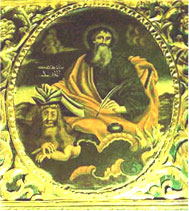 |
Feast: April 25.
The second Gospel was written by St. Mark, who, in the New Testament, is sometimes called John Mark. Both he and his mother, Mary, were highly esteemed in the early Church, and his mother’s house in Jerusalem served as a meeting place for Christians there.
St. Mark was associated with St. Paul and St. Barnabas (who was Mark’s cousin) on their missionary journey through the island of Cyprus. Later he accompanied St. Barnabas alone. We know also that he was in Rome with St. Peter and with St. Paul. Tradition ascribes to him the founding of the Church in Alexandria. St. Mark died after being dragged along the main street of Alexandria in Egypt.
St. Mark wrote the second Gospel, probably in Rome sometime before the year 60 A.D.; he wrote it in Greek for the Gentile converts to Christianity. Tradition tells us that St. Mark was requested by the Romans to set down the teachings of St. Peter. This seems to be confirmed by the position which St. Peter has in this Gospel. In this way the second Gospel is a record of the life of Jesus as seen through the eyes of the Prince of the Apostles.
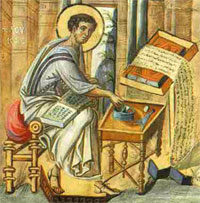 |
Feast: October 18.
St. Luke was born at Antioch, Syria, according to the Church historian Eusebius. He was a Gentile by birth and a physician by profession. According to a legend of the 6th century he was also a painter.
He was one of the earliest converts to the Faith and later became the missionary companions of St. Paul, whom he accompanied on part of his second and third missionary journeys, and attended during his Caesarean and Roman captivities. Little is known with certainty of his subsequent life. It is believed that he was hanged on a big olive tree in Greece.
The unanimous tradition of the Church ascribes the third Gospel to St. Luke. Allusions to and citations from the Gospel are most frequent in early Christian writings, and even heretics made diligent use of this inspired book. The Gospel itself shows that its author was a person of literary powers, a physician, and a companion of St. Paul. Early Christian tradition ascribes the Gospel and its companion volume, The Acts of the Apostles, to approximately 75 A.D.
Little is known with certainty about the place of composition. Some of the ancient authors suggest Achaia (Greece); some of the manuscripts mention Alexandria or Macedonia; while modern writers also defend Caesarea, Ephesus or Rome. As an artist, St. Luke shows his skill in portraying living characters, and he was remained an inspiration to painters for centuries. Tradition speaks of St. Luke as the Church's first iconographer. It was St. Luke, we are told, who wrote the first icon of the Holy Theotokos, bearing in her arms the Christ Child. (The icon of Virgin Mary with infant Jesus in the St. Mark's Monastery of the Syrian Orthodox Church in Jerusalem is attributed to St. Luke). As a historian, he is comparable with the great Greek and Latin writers. In his Gospel there is a steady movement of events from Nazareth to Jerusalem, whereas in the Acts it is from Jerusalem to Rome.
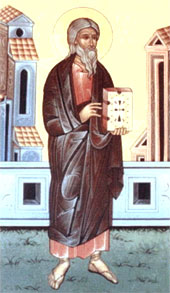 |
Feast: June 11.
Though not one of the Twelve, St. Barnabas is considered an Apostle by the Church. He was a Jew of the tribe of Levi, but born in Cyprus, where the family settled. His success in preaching prompted the Apostles to change his name of Joseph to that of Barnabas-which means “son of exhortation” or “consolation.” He also was noted for his generosity in the early Christian community of Jerusalem (Acts 4, 36-37).
It was St. Barnabas who befriended the recently converted and former persecutor of the Church, Saul of Tarsus, and set him on the path to becoming the great Apostle Paul by introducing him to the Apostles (acts 9, 27). When St. Barnabas went to Antioch to consolidate the infant Church there, he asked St. Paul to share his labours. After labouring a year at Antioch, the two Apostles brought the offerings of the community to the famine-stricken poor of the Judean community (acts 11, 27-30).
Together with St. Paul, Barnabas preached the Faith in Cyprus and central Asia (Acts 13-14) and attended the First Council of Jerusalem (Acts 15, 1-29). But on their return to Antioch they parted company when St. Barnabas wanted his nephew John Mark to accompany then on their second missionary journey while St. Paul did not (Acts 15, 30-40); accordingly, St. Barnabas went back to Cyprus with John Mark (acts 15, 3-40). The subsequent events of the life of St. Barnabas are not known for certain, except that he was known to the Corinthians (1 Cor. 9, 6). A tradition relates that he died at Salamis in Cyprus, after being stoned.
Note:
[a]. Feast of the Twelve Apostles together is celebrated on June 30th.
[b]. DISCIPLES WITH THE SAME NAME:-
i. Jesus had two Disciples with the same name Simon. One was St. Peter the chief of the Apostles whose another name was Kefa. The other was Simon the zealot or Simon of Canan.
ii. There were two disciples with the same name Jacob (James). One was Jacob, the son of Zebedee. The other Jacob was the son of Alphaeus. He was known as Jacob, the Less and the brother of Our Lord.
iii. There were two disciples named Jude. One was son of Alphaeus. He was also known as Thaddeus. The other was Jude Iscariot who betrayed Jesus.
[c] BROTHERS AMONG THE DISCIPLES:-
i. Simon Peter and Andrew
ii. Jacob and John (Sons of Zebedee)
iii. Jacob, the Less and Thaddeus (sons of Alphaeus)
Sources:
(a) "Lives of the Saints" by Rev. Hugo Hoever, S.O,Cist., Ph.d. Catholic Book Publishing Co. New York, 1955
(b) Syriac Orthodox Resources, http://sor.cua.edu
(c) Vol. III of "The Lives or the Fathers, Martyrs and Other Principal Saints" by Rev. Alban Butler
(d) The Oxford Dictionary of the Christian Church (1997)
(e) Icons from the Syriac Orthodox & Greek Orthodox web sites